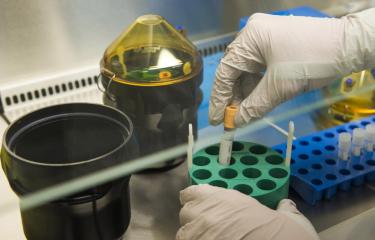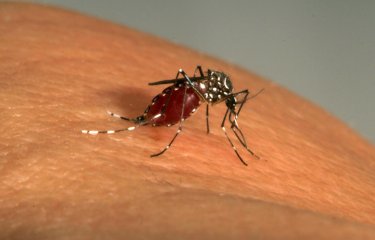An international coalition of scientists* involving teams from the Institut Pasteur, has revealed that adaptive mutations to the Ebola virus occurred during the epidemic that swept across West Africa from 2013 onwards. In what remains the most devastating outbreak of this disease ever recorded, it was already known that several strains of the virus circulated at the same time. This new functional study demonstrates that some variants of the virus actually increased their ability to infect humans – to the detriment of their infectivity in bats…
* The University of Nottingham (UK) ; Institut Pasteur (Paris, France) ; CNRS (France) ; Institut Pasteur de Dakar (Senegal) ; Public Health Agency of Canada (Canada) ; University of Manitoba (Canada) ; University of Bonn Medical Center (Germany) ; The University of Sydney (Australia) ; Université Laval (Canada) ; University of Pennsylvania (USA).
The Ebola virus causes severe hemorrhagic fever that often prove fatal to humans. During the epidemic that swept across West Africa from 2013 to 2016, the virus infected at least 28,000 people and killed more than 11,000. Since the discovery of the Ebola virus in 1976, this outbreak is the most severe ever recorded and the first in this region of Africa, which had previously been spared. This zoonosis only rarely crosses over into humans (bats are thought to be its natural host), and the virus had never before spread so widely, and above all over such a long period, in humans. It is crucial that we draw as many lessons as possible from this epidemic, such as understanding how the virus can change and adapt in this situation.
"We studied more than 1,600 Ebola virus sequences that were sampled during the epidemic in Guinea, Sierra Leone, Liberia or Mali and have been shared by and among the scientific community, to identify the variants that spread the most," explained Etienne Simon-Lorière from the Institut Pasteur's Functional Genetics of Infectious Diseases Unit. These teams studied mutations in the gene encoding the viral envelope protein and observed that some of them significantly increased the virus' ability to infect humans.
One mutation in particular, A82V, attracted the attention of our scientists – and that of another team whose study is published in the same issue* – since it appeared very early on in the epidemic. This change in a single amino acid at the binding site with the viral receptor makes Ebola much more infectious for humans and primates.
*Ebola Virus Glycoprotein with Increased Infectivity Dominated the 2013–2016 Epidemic. William E. Diehl, Aaron E. Lin, Nathan D. Grubaugh, (...), Kristian G. Andersen, Pardis C. Sabeti, Jeremy Luban. Cell, 3 novembre.

Scientists at the Institut Pasteur in Dakar study strains of the Ebola virus circulating in Guinea in 2014. © Institut Pasteur in Dakar
"We demonstrated that the virus became much more efficient to infect human cells. We may speculate as to whether these changes contributed to the scale of the severe epidemic that struck in 2013-2016 – in addition, of course, to epidemiological factors," commented Etienne Simon-Lorière.
Another observation by the scientists was that these mutations which optimize virus entry into humans actually reduce infectivity in bat cells. "That's what makes this study so fascinating and worthwhile: it shows how slight changes, some interacting remotely along the viral envelope, can make a virus more or less infectious for a given host."
This opens up a vast field of research for scientists as they seek to understand how these viruses evolve during the various stages of an epidemic so that they can be better equipped to anticipate similar public health problems in the future.
Source
Human Adaptation of Ebola Virus during the West African Outbreak, Cell, november 3.
Richard A. Urbanowicz1,2, C. Patrick McClure1,2, Anavaj Sakuntabhai3,4, Amadou A. Sall5, Gary Kobinger6,7,8,13,14, Marcel A. Müller9, Edward C. Holmes10, Félix A. Rey11,12, Etienne Simon-Loriere3,4, and Jonathan K. Ball 1,2,15.
1. School of Life Sciences, The University of Nottingham, Nottingham NG7 2RD, UK
2. NIHR Nottingham Digestive Diseases Biomedical Research Unit, The University of Nottingham, Nottingham University Hospitals NHS Trust, Nottingham NG7 2UH, UK
3. Functional Genetics of Infectious Diseases Unit, Institut Pasteur, 75724 Paris Cedex 15, France
4. French National Center for Scientific Research (CNRS), Associated Research Unit 3012, 75015 Paris, France
5. Arbovirus and Viral Hemorrhagic Fever Unit, Institut Pasteur in Dakar, BP 220 Dakar, Senegal
6. Special Pathogens Program, National Microbiology Laboratory, Public Health Agency of Canada, Ottawa, ON K1A 0K9, Canada
7. Special Pathogens Program, National Microbiology Laboratory, Public Health Agency of Canada, Winnipeg, MB R3E 3R2, Canada
8. Department of Medical Microbiology, Faculty of Medicine, University of Manitoba, Winnipeg, MB R32T 2N2, Canada
9. Institute of Virology, University of Bonn Medical Center, 53127 Bonn, Germany
10. Marie Bashir Institute for Infectious Diseases and Biosecurity, Charles Perkins Centre, School of Life and Environmental Sciences and Sydney Medical School, The University of Sydney, Sydney, NSW 2050, Australia
11. Institut Pasteur, Department of Virology, Structural Virology Unit, 75724 Paris Cedex 15, France
12. French National Center for Scientific Research (CNRS), Joint Research Unit 3569, 75724 Paris Cedex 15, France
13. Present address: Department of Microbiology, Infectious diseases and Immunology, Université Laval, QC G1V 0A6, Canada
14. Department of Pathology and Laboratory Medicine, University of Pennsylvania, Philadelphia, PA 19104, USA
Mis à jour le 10/11/2016








